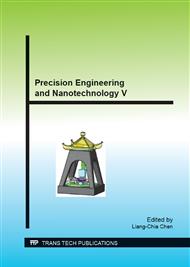p.267
p.274
p.282
p.288
p.297
p.305
p.310
p.316
p.322
A Differential Evolution Stereo Matching Method in Digital Image Correlation
Abstract:
Stereo matching is widely used in three-dimensional (3D) reconstruction, stereo machine vision and digital image correlation. The aim of stereo matching process is to solve the well-known correspondence problem, which tries to match points or features from one image with the same points or features in another image from the same 3D scene. There are two basic ways, correlation-based and feature-based, are used to find the correspondences between two images. The correlation-based way is to determine if one location in one image looks/seems like another in another image, and the feature-based way to find if a subset of features in one image is similar in the another image. In stereo matching, a simple algorithm is to compare small patches between two rectified images by correlation search. For the pair images acquired from two cameras inevitably exists some rotation transformation, the algorithm first runs a preprocessing step to rectify the images with the epipolar rectification to simplify the problem of finding matching points between images. The epipolar rectification is to determine a transformation of each image plane such that pairs of conjugate epipolar lines become collinear and parallel to one of the image axes. It will lead the loss of gray information of images. The effect is dependent on the amount of angle. When the angle is big enough, the correlation search may yield error results because of retrograded correlation effect. In order to solve the problem, the paper presents an improved stereo matching algorithm with differential evolution to solve the correspondence problem. Our method doesn’t need to runs the preprocessing step to rectify the images with the epipolar rectification. It uses a differential evolution algorithm to minimize the correlation function which contains the angle information after acquiring the epipoar geometry constraint of two image pairs. Then it utilizes a flood-fill algorithm to search correspondence sub-region in the area around the epipolar line. The flood-fill algorithm can overcome the problem of the traditional row-column scanning search method, which will encounter boundary barrier where exists concave polygons or cavities. The Experimental results show that the proposed method can be easily implemented in stereo matching without loss of information of image features with large rotation angle transformation. In the paper, we will introduce the stereo matching principle and its algorithms, including the differential evolution algorithm for finding the correspondences with large rotation transformation between stereo image pairs and the flood-fill traversal strategy for matching large area with complex concave polygons or cavities. In the end of the paper, some experimental results will be given to illustrate the method effectiveness. Keywords: digital image correlation, stereo matching algorithm, epipolar geometry, flood fill algorithm, differential evolution, rotation angle
Info:
Periodical:
Pages:
297-304
Citation:
Online since:
August 2014
Authors:
Price:
Сopyright:
© 2015 Trans Tech Publications Ltd. All Rights Reserved
Share:
Citation:


